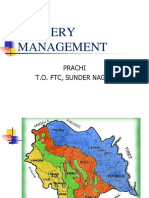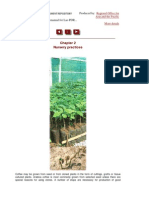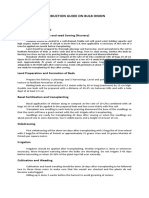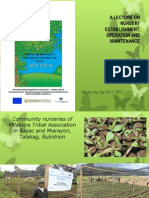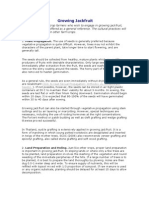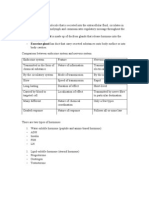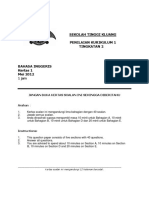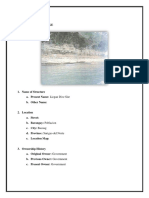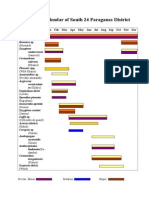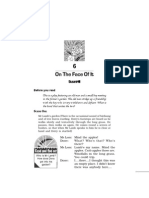Professional Documents
Culture Documents
Papaya Cultivation
Uploaded by
Udaya KumarOriginal Title
Copyright
Available Formats
Share this document
Did you find this document useful?
Is this content inappropriate?
Report this DocumentCopyright:
Available Formats
Papaya Cultivation
Uploaded by
Udaya KumarCopyright:
Available Formats
PAPAYA
Papaya, papaw or papita (Carica papaya L.) originated from tropical America, has become a
popular fruit due to its fast growth, high yield, long fruiting period and high nutrient value as well.
In addition it has been use as vegetable, fruit processing, and papain production at immature stage. It
can be a highly profitable crop now.
The papaya plant has male, female, hermaphrodite (bisexual flower) and some other complex forms.
Male plants do not bear any fruit, Normally the fruit shape from female plant is shorter, but the fruit
shape from hermaphrodite (bisexual flower) plant is longer.
The seeds of following varieties we offer in grow in mixture of female plants and hermaphrodite
plants.
Known - You Seed 1
PDF created with pdfFactory trial version www.pdffactory.com
I. CLIMATE AND SOIL CONDITION
Papaya is a tropical, plant, very sensitive to frost. Optimum temperature is 25 - 30 C and
minimum 16 C. The suitable ph value is between 6 and 6.5. The well-drained or sandy loam soil
with adequate organic matter is most important for the papaya cultivation. In high rainfall area, if
drainage is poor and roots are continuously drenched for 24 to 48 hours, it may cause the death of
the plants. Sticky and calcareous soils are not good as rain water may accumulate in the soil even
only for a few hours. In this case, higher raised bed and drainage ditch are recommended.
The growing field should be irrigable and kept at suitable soil moisture which is necessary for
the growth of papaya plants, although dry climate at the time of ripening is good for the fruit quality.
Continuous cropping in the same field may result to poor growth and cause disease problem of
papaya trees. Papaya does not like strong, cool, hot, dry or salty wind. It is better to grow in
sheltered but full sunshine place. Staking and/or windbreak can decrease the damage to plants under
strong wind.
II. RAISING SEEDLINGS
A. Seed Source:
The seed must be from dependable source and sown as soon as possible. The remaining
seeds must be sealed tightly and kept at cool (5 -10 C) and dry (under relative humidity
40%) place.
B. Seed requirement:
One gram contains about 50 - 80 seeds, mostly 65 -75 seeds. It needs 50 to 80 g seeds per
hectare at one plant per hill average of 80 % seed germination and 80% successful seedlings.
C. Growing season:
The time of sowing depends upon the choice of fruiting season and danger of rain or frost. In
northern part of Taiwan, (around N 24) seeds are sown from March to May and transplanted
from May to July. IN central and south areas (around N22, 23), seeds are sown almost all
year round, but optimum season is from February to March (Spring) or from September to
November (Autumn).
D. Seed germination:
The optimum temperature is 21 - 27 C, and of radical emergence is 19 - 29 C. it take 1 - 4
weeks from sowing to emerge depending on the temperature. The seed may be treated with
Thiram (TMTD) W.P. before sowing to control the fungus diseases at young stage.
E. Sowing method:
It may be sown directly, but normally, it is better to be seeded to raise seedlings and
transplanted.
Known - You Seed 2
PDF created with pdfFactory trial version www.pdffactory.com
1. Plastic bag or soft plastic pot sowing:
Transparent plastic bag in 8 - 9 cm wide and 8 cm wide and 8 cm high or black
soft plastic pot is used for raising seedlings. Drainage hole is required. Then fill
with the mixture of sandy loam virgin soil and sand at the ratio3: 1. Sow 1 or 2
seeds each bag (pot)and cover with well fermented compost, then water fully.
Cover the bags (pots) with plastic film or thatch such as straw sheets or used
jute bags to keep warm and wet till emergence. Meanwhile, keep the air fresh
and moist, and then remove the cover gradually for fitting the seedling under the
sun shine.
2. Seedling Tray sowing:
The use of plastic seedling tray is new way of seedling culture to obtain the healthy
seedlings which are easily for the transporting and transplanting. The Tray size may be
74 to 82 holes at 4.5 cm each in diameter. Fill the prepare media in the holes, sow 1 to 2
seeds in each hole, and cover the layer of media. Other procedures are similar to plastic
bag (pot) sowing.
For purposes of controlling aphid, viral infection, rain and wing protection, and
maintaining tolerable temperature during seedling stage, it is required to use screen house,
greenhouse or tunnel covered with 0.07-0.10 mm plastic film or 32 - mesh net. Black
plastic net is also usually used for shading. During the seedling stage, semi-humid
environment is preferred. For better aeration, the film may be covered during the cool
night or heavy rain period and opened in the warm day time. The site of the bag, pot or
tray should be changed if the roots of seedling penetrate into the soil. In this way, it will
induce more new roots and healthy seedlings.
III TRANSPLANTING
A. Transplanting stage:
When the seedling is 10 -15 cm tall, it should be transplanted, but 30-40 cm is also all
right if it is grown in a larger container.
B. Spacing:
A 40-60 cm high bed is required if the soil is not well drained. Normally, the distance
between rows is about 2-2.5 m, and 2 m between plants (or 3m x 3m when grown at
sloping land, or 2.7 m of distance between beds for the tractor practice). The total
number of plants for each hectare is about 2,000 to 2, 5000. In case of eradication of
undesirable sexual or virus infected plants later, the distance between plants at
beginning of planting may be 1.2-1.5 m.
C. Pollinator Plants:
Minimum10-20% hermaphrodite plants are required for pollination.
D. Planting method:
(A) Black-and-white plastic mulching film on the beds can be used to:
Known - You Seed 3
PDF created with pdfFactory trial version www.pdffactory.com
(a) Reduce the loss of water and fertilizer nutrient
(b) Control weed
(c) Repel the winged aphids
(d) Decrease virus infection at young stage
(e) Decrease bed soil erosion.
(B) Drill the planting hole about 45 cm in diameter and 30 cm in depth.
The soil in the hole is mixed with compost for planting. Then transplant the
Seedlings (seedlings should be fully watered one day before transplanting)
On a cloudy day or late afternoon to minimize transplanting shock. Take care
Not to plant too deep, otherwise collar-rot disease may affect the buried part
Of the stem. Then water immediately after planting.
(C) Intercrop with the newly-planted long term fruit trees such as orange.
Short term crop such as corns or vegetables may also be considered but not
Necessary.
(D) To retard growth, lower the fruit - setting site, resist the wind facilitate
Management and harvesting, slant planting is considered as follows:
Plant the seedlings at the angel of 45 C between the stem and surface of
Soil and then later cut the leaves, which touch the soil. Fix with rope at two
thirds of the stem from the base and adjust the site up when the plant grows
higher to prevent the stem from being upright.
Above procedures may be modified to fix the plant with plastic rope
down to the side(s) of bed about 1-2 months after transplanting (about 36-40
cm height of the plant).
(E) Screen house cultivation: For reducing virus infection during growing
Period, the following cultivation is recommended:
Use 3.0 - 3.6 m long of bamboo stems or concrete stakes as supporters
at a distance of 4.5 - 5m, and connect with No.12 iron wire. Then tightly
surround with 32- mesh white net, which contains anti-ultra violet material.
After the construction is completed, the protected healthy seedlings are
planted and planted and the virus-infected plants destroyed and buried
immediately once found. Note that hand pollination for female trees is
required (the central flower of the cluster on the bisexual plants can be taken
as pollen supplier) and control the powdery mildew and mites well. The net
may be taken off before the fruit is mature.
IV. Fertilization
The plant needs continuous fertilization, as fruiting is continuous upon maturity.
Recommended rate of fertilizers for papaya is as follows:
(it should be modified depending upon the soil conditions)
A. Basal fertilization:
Apply 10 tons of fermented compost per hectare (or 1 kg per square meter) before
planting or when forming beds. The same dose should be repeated every year for
the adult plants
Known - You Seed 4
PDF created with pdfFactory trial version www.pdffactory.com
B. Side dressing: Apply NPK at rate of 4:85 monthly, bimonthly or
Seasonally. Following fertilizers in kg is for 100 plants in the period:
Age N P K Total Frequency
Within 6
months
between 6-12
months
between 1-2
years
between 2-3
years
5.6
25
35
58
12
54
75
134
2.4
11
15
20
20
90
125
212
2-3
2-3
4-6
4-6
(C) Others: Apply 0.25 - 0.5 kg borax per 100 plants right before dry season
In which is boron-deficient. For the young trees, apply compound
fertilizers in the trench (10 cm deep and 15 cm wide) around the outer of
tree crown, then fill back the soil, or top dress at furrows after irrigation
V. Weed control
Weeds should be removed at the young stage frequently and lightly, but never do deep tillage
to the soil since the plant has shallow roots. Growers may apply herbicide once before
emergency with 43% lasso E.C. at 1:200 or 80% Kamex W.P. at at 1:400; or mulch the bed
with the plastic film before transplanting or with rice / sugarcane straws before or within a
few days after transplanting to control the weeds, soil erosion and water loss..
VI. Irrigation
Normally, irrigate every 10 days in winter or every week in summer, but practise varies
according to soil, climatic conditions, and irrigation methods. Ring method, furrow or drip
irrigation can be done. However, be sure to prevent the water from coming in contact with
the stem. Irrigation may prevent the plants from the damage of frost.
Known - You Seed 5
PDF created with pdfFactory trial version www.pdffactory.com
VII. Other Management
A. Remove the side shoots of the stem as soon as possible.
B. Cut the old, dry, or disease leaves and petioles.
C. Thin the fruits, which are poorly pollinated, malformed or pest- infected. Nevertheless, avoid
transmitting the virus mechanically from infected plant to others through the above practices.
D. Support the plant with stakes, which should tide with the rope, especially when bearing
heavy fruits and during storm season.
E. Pollinate by hand to increase the fruit setting and the percentage of large and normal fruits,
especially when growing net house.
F. Management after storm
1. Drain the plantation well.
2. Apply the fungicide to control phytophthora blight.
3. Spray 0.5% urea or side dress the fertilizers.
4. Support the fallen trees to keep them from the surface of the soil.
5. Cover the fruits with paper to avoid the sun scald.
6. Thin the small fruits if the trees are severely damaged.
VIII. Harvest
In general, papaya takes six months to flower and another five for harvesting; but it may vary
according the climate conditions and management. For shipping to the distant markets the
fruits should be harvested when the apical and starts turning yellow and the latex is no longer
milky. During the cold months the fruits can be left on the tree to develop deeper color and
obtain better flavor.
Step ladder or plumber s helper with long bamboo pole is usually used by the small
growers to pick the fruits if the trees grows too tall. The bin attached to the tractor is used for
harvesting in large plantation. The fruits can matcher well by treatment of calcium carbide or
ethylene gas.
IX. Pest control and micro - element deficiency management
(Please refer to your local recommendation for chemical control)
A. Papaya Ring Spot Virus (PRSV) and Papaya Leaf-Distortion Mosaic Virus (PLDMV)
PRSV induces vein - banding mottling and yellowing spot or distortion of leafs, water
soaking streaks on and petioles, and ring spots appear on fruits or even on leaves. It stunts
the plants and drastically reduces the size of fruits, sugar content, and taste. Some infected
plants will bear fruit or production would decline. It spreads very fast and has become the
limiting factor in papaya production in many areas of the world.
Known - You Seed 6
PDF created with pdfFactory trial version www.pdffactory.com
PLDMV induces characteristics rosettes of leaves with slender stems on the crown top. The
fruit has the same markings as PRSV, but there are bumpy swellings around the ring spots.
Both viruses are transmitted by sap (via mechanical means) or aphids. No evidence has been
found that they are seed transmitted.
Control:
1. Select to grow the tolerant varieties such as Known You No. 1 and Red Lady.
2. Grow the seedlings and trees under the net house or screen house.
3. Transplant at a time when there are relatively few winged aphids around and protect the
seedling with transplant cylindrical plastic film and supports.
4. Inter- crop papaya with barrier crop such as corn, but never host crops such as cucurbit.
(May sow the corn seed one month after transplanting)
5. Mulch silver and black plastic film to deter winged aphids from visiting young seedling.
6. Immediately eradicate and burry the whole infected plant once found
7. Do not touch the healthy plants if hand or foot is contaminated with infected plant
8. Control the aphids
9. Practice cross protection with specific mild strain, but it often breaks down after a few
months, losing its affectiveness.
10. Papaya tree may be treated as an annual crop and requires replanting every year in order
to cut down on virus infection in the area where virus occurs seriously
B. Damping-off (Pythium aphanidermatum, P. ultimum, Phytophthora palmivora and
Rhizoctonia sp.) The fungi live in the soil. The disease is favored by high temperature and
wet weather, wet soil, poor drainage, deep sowing, thick sowing (crowded), poor soil
aeration, high nitrogen in the soil and sunshine shortage. Infected seedlings will wilt, fall
and then die.
Control:
1. Use virgin soil or sterlize the soil with steam at 180F (82.3C) for 30 minutes or
fumigate with methyl bromide (see manufactures recommendations)
2. Improve above mentioned enviormental conditions to be favorable to the seedlings.
3. Protect with plastic film from rain water.
4. Drench the slution of 35% Etridiazole (Terrazole)
C. Phytophthora Fruit Rot (Phytophthora palmivaro)
Occurs in the hot and humid season, especially after typhoon attacks. It induces root rot on
young and adult plants, and finally wilts or dies. Also it may cause large lesions and white mold
appears on the fruit and then fruit drops.
Known - You Seed 7
PDF created with pdfFactory trial version www.pdffactory.com
Control:
1. Rotate with other crops.
2. Select well drained soil.
3. Avoid harming the roots.
4. Control the snails and ants.
5. Rogue and deply bury the diseased fruits.
6. Spray 80% Mancozeb (Dithane M - 45) W.P. at 1:400 weekly.
D. Powdery Mildew (Oidium caricae)
White and gray powder-like mold appears on the leaves, petioles, stem and young fruits in early
spring season (around 18-22 C). It stunts the plant, induces leaf dropping, or does not set fruit.
Control: Spray one of the following fungicides with the sticker at 10-14 intervals.
1. 50% benomyl (benlate) W.P. 1:3000
2. 70% wettable sulfur at 1:400
3. 10.5% Penconzaole E.C.1: 2000 phytotoxic to seedling.
4. 50% Binapacryl W.P 1:2000 phytotoxic to seedling.
5. 18.6% Triforine E.C. 1:1000 phytotoxic to seedling.
6. 19.5% Dinocap W.P.1:1500 phytotoxic to seedling.
Caution should be taken that the above mentioned chemicals may injure papaya at high temperature
or/and at high high concentration.
E. Anthracnose ( Colletotrichum gloeaporides,, Glomerella cingulata)
It attacks the petioles and fruits. Symptoms mainly appear on the mature fruit and thus
shorthen its shelf life. The symptoms are usually round, water soaked lesions which if
enlarged, will be slightly sunken. The fungus frequently produces light-orange masses of
spores in the central lesion.
Control:
1. Weekly spray 80% Mancozeb (Dithane M -45) W.P. 1:400 with spreader/sticker. 2.Treat
the harvested fruits with hot water at 49C for 20 minutes, then dip in the cool water for 20
minutes and then dry it.
F. Black Spot (Asperisporium caricae, Caercospora papayae)
The leaf spots are grayish-white, roughly circular to irregular in shape. Heavily infected
leaves turn yellow and dry up. The spots on fruit are tiny water-soaked, turning black and
corky. Wet and cool place at hill side is more serious.
Known - You Seed 8
PDF created with pdfFactory trial version www.pdffactory.com
Control: Please refer to Anthracnose control.
G. Root Rot (Rhizoctonia solani, Fusarium sp.)
It causes root decay, eaf yellowing, and failing plant after raining. It also kill young seedlings
in the nursery.
Control:
1. Rotation
2. Good drainage
3. Staking
4. Sterilization of the nursery bed with formaldehyde two weeks before sowing or
treating the seeds with thiram (TMTD) or captan.
H. Collar Rot, Foot Rot (Pythium aphanidermatum)
Symptoms include swellig, cracking and rotting of the stem, when it comes in contact with
water during the rainy season.
Control: Please refer to Damping-off control.
I. Stem-end Rot (Ascochyta sp. And other fungi)
A dry, firm, dark rot usually occurs after picking. It starts at the stem-end and extends into
the fruit.
Control: Pick the fruits with part of peduncle.
J. Rhizopus Fruit Rot (Rhizipus stolonifer)
The fungus invades injured mature fruit only It causes soft rot and produces masses of
visible black sporangia; leakage of cell fluids from the rotting fruit will also occur.
Known - You Seed 9
PDF created with pdfFactory trial version www.pdffactory.com
Control:
1. Be careful when picking, transporting and packing to avoid bruising or injuring the fruit.
2. Heat treatment to kill the pathogen.
3. Remove and destroy the rotting fruit in the packing sheds.
K. Black Rot (Erwinia cypripedii)
The symptom mainly appears on the top of the stem. It primarily causes water-soak, then
turns to black and leaves fall. New shoots may be infected and finally the plant dies.
Occasionally the symptom of water-soaked lesions are found on the leaves and petioles and
will turn to brown angular and necrotic spots. Bacteria also invade the flesh, induce brown
spots and decay, producing poor odor.
Control:
1. Eradicate the severely infected plant.
2. Cut the infected portion of the stem under sunny day, then paste with sulfur to develop
the new shoot.
3. The seriously infected plantation should be destroyed.
L. Boron Deficiency.
This physiological problem is common in the sandy or gravel soil during dry cool season.
The latex could be found on the surface of immature fruits. Gall-like malformation of the
fruit is also found in the severe plantation. The fruits are hard and not easy to get ripe,
tasteless and having no commercial value.
Control:
1. Use more organic manure
2. Dissolve the Borax in hot water, then spray 0.25% Borax or Boric acid solution on the
leaves at the beginning of dry season at 2-3 weeks intervals.
3. Apply 2.5-5g Borax per plant (5-10kg/ha) along with other fertilizers bby side dressing at
the beginning of dry season.
Known - You Seed 10
PDF created with pdfFactory trial version www.pdffactory.com
M. Nematode Diseases
2. Reniform Nematode (Rotylenchulus Reniformis)
The young female nematode penetrates the root, causing stunting of the trees which are
stressed and wilt more readily than the healthy ones. Fruits are smaller and may become
tasteless as well.
3. Root-knot Nematode (Meloidogyne sp.)
It causes swelling or retardation of the root and stunting of the plants.
Control:
1. Rotate after rice crop.
2. Control with nematocide.
N. Mites
1. Spider Mites:Carmine Mite (Tetranychus cinnabarinus): It infests widely on many kinds
of plants and more seriously on papaya. The leaves become matted with webbing.Citrus Red
Mite ( Panonychus citri) & Texas Citrus Mite ( Eutetranychus banksi): The outbreaks of both
mites occur only periodically, usually during the fall, causing matted but not prominent
webbing, and inducing bleached punctures on leaves. The premature leaves drop and the
plants become weak. The damage may widely spread rapidly.
2. False Spider Mites: Red and black flat mite (Brevipalpus phoenicis): It causes
corky scarring of papaya fruit and reduces its market value. The mite is found onto
the stem and advances onto the petioles and fruits.
3. Tuckerellid Mites: Twelve -tailes Tuckerellid (Tuckerella pavoniformis): It is
minor pest. Injurious symptom is similar to that caused by red and black flat mite.
Known - You Seed 11
PDF created with pdfFactory trial version www.pdffactory.com
Control:
1. Fungicide such as Binapacryl, Trifornine, Dinocap used for powdery mildew control is
also effective on spider or false spider mites. Spray 25% Morestan W.P. at 1:1000~1500
or 50% plictran W.P. at 1:2500~3000 at 10-15 days intervals.
Notice that too high concentration or/and high temperature may cause plant injury. Also,
do not use the same chemical continuously because in this way, the mites may become
tolerant to pesticide.
3. Tarsonemid Mite
Broad mite (Hemitarsonemus latus): It damages the seedlings and young plant greatly,
causing stunted and distorted leaves. In a serious situation, the rosette leaves will appear,
and the growing tips may be aborted.
Control: Spray 75% wettable sulfur at 1:300 on the top of stem at 10-15 days
intervals until normal new leaves occur.
O. Aphids (Myzus persicae, Aphis spp.etc.)
Aphids suck young leaves whish become curled and crinkled, and even defoliate, especially
at seedling stage. Some aphids also transmit the virus diseases
P. Red Scale (Aonideilla inornata)
It mainly infests stem after flowering and then spreads to the fruits.
Control: Spray one of the following pesticides at 7-10 days intervals.
1. 33% Formothion E.C. at 1:660
2. 50% Malathion E.C. at 1:500-1000
3. 44% Methidation E.C. at 1:1000
4. 40% Methidation E.C. at 1:800
The above pesticides are also effective to control aphids and some other insects of
Papaya.
Known - You Seed 12
PDF created with pdfFactory trial version www.pdffactory.com
Q. Other Insects:
Scales, thrips, beetles, stink bug, leaf hopper, moths., mealy bug, and white fly are
minor insects, but may occasionally cause certain damage to papaya.
Control:
1. Keeping the plantation relatively free of weeds can control aphids, leaf hopper and
thrips outbreaks to a large extent.
2. Harvest all the fruits at the mature-green stage, and then pick dispose of all soft ripen and
infested fruits promptly to prevent fruit fly infestation and reproduction within the plantation.
3. Select the proper insecticide to control the outbreaks of certain insects.
Biological Control: Apply the eggs of Mallad basalis walker (20-60 eggs/ plant or 100,000
eggs/hectare) to control mites, aphids, white flies if the papaya is grown in the screen house.
R. Snail and Slug: It feeds on young plants, shoots, or flower buds in humid place. Also, it can
transmit the pathogen of phytophthora fruit rot.
Control:
1. Grow the seedlings at a safe place.
2. Collect the snails in the evening and at dawn and properly dispose them of.
3. Protect with big plastic cylinder film after transplanting. (This may also protect from virus
infection)
4. Apply Arttitox 10-15 granules each square meter.
Note: The above information is provided based on research and field observation. Variations in
local condition may affect the information and suggestions contained above and for which the
company should not be held liable. In case of doubt, it is recommended to carry out ordinary trial
production in order to test local growing condition in different seasons and area.
PDF created with pdfFactory trial version www.pdffactory.com
You might also like
- Ornamentals Module LandscapingDocument16 pagesOrnamentals Module LandscapingDeejay BeekayNo ratings yet
- Tugas B.inggris NandaDocument10 pagesTugas B.inggris NandaAbi Yandra GintingNo ratings yet
- How To Grow Eggplant With Cost AnalysisDocument5 pagesHow To Grow Eggplant With Cost AnalysisJessielito P. AmadorNo ratings yet
- Protected Cultivation of Vegetables-1Document65 pagesProtected Cultivation of Vegetables-120 012 Infant Manicka Raj JNo ratings yet
- Nursery Management: Prachi T.O. FTC, Sunder NagarDocument43 pagesNursery Management: Prachi T.O. FTC, Sunder Nagarsheynie penalosaNo ratings yet
- S K Mangal - Coffee - Planting, Production and Processing-Gene-Tech Books (2007) - 51-59Document9 pagesS K Mangal - Coffee - Planting, Production and Processing-Gene-Tech Books (2007) - 51-59Fandyka RizaNo ratings yet
- My Technoguide For Ampalaya Production Part 1Document39 pagesMy Technoguide For Ampalaya Production Part 1haroldlacaba67% (3)
- Designing and Managing a Tree NurseryDocument29 pagesDesigning and Managing a Tree NurseryHaseeb A Chaudhry75% (4)
- S K Mangal - Coffee - Planting, Production and Processing-Gene-Tech Books (2007) - 51-59Document9 pagesS K Mangal - Coffee - Planting, Production and Processing-Gene-Tech Books (2007) - 51-59Fandyka RizaNo ratings yet
- Guide: Suggested Cultural Practices For Bitter GourdDocument5 pagesGuide: Suggested Cultural Practices For Bitter GourdSaurabh NagwekarNo ratings yet
- AGR 201 - Week 8 E-NotesDocument16 pagesAGR 201 - Week 8 E-Notesdaisyokoth6No ratings yet
- Lab Activity Propagation of Selected Tropical Fruits and Plantation CropsDocument10 pagesLab Activity Propagation of Selected Tropical Fruits and Plantation CropsJevelyn Mendoza FarroNo ratings yet
- Manual For Mango ProductionDocument9 pagesManual For Mango ProductionFrench Neco TupasNo ratings yet
- Lab Activity Propagation of Selected Tropical Fruits and Plantation Crops1Document11 pagesLab Activity Propagation of Selected Tropical Fruits and Plantation Crops1Jevelyn Mendoza Farro100% (1)
- Container-Grown Container-Grown Container-Grown Container-Grown Container-Grown Nursery Trees Nursery Trees Nursery Trees Nursery Trees Nursery TreesDocument7 pagesContainer-Grown Container-Grown Container-Grown Container-Grown Container-Grown Nursery Trees Nursery Trees Nursery Trees Nursery Trees Nursery TreesBrij Mohan SinghNo ratings yet
- Compilation of Information On Growing Ampalaya (Bitter Gourd) in The PhilippinesDocument38 pagesCompilation of Information On Growing Ampalaya (Bitter Gourd) in The PhilippinesPeter Rice86% (22)
- Fundamental of Horticulture-Shobhit MauryaDocument42 pagesFundamental of Horticulture-Shobhit MauryaOm MauryaNo ratings yet
- LanzonesDocument29 pagesLanzonesrichardmaravillas100% (6)
- About CocoaDocument10 pagesAbout CocoamykarusinNo ratings yet
- 17 26 1271 Technical Bulletin 50 Seed Production in Trays English RevisedDocument3 pages17 26 1271 Technical Bulletin 50 Seed Production in Trays English RevisedJuan MayorgaNo ratings yet
- Family: Palmae Scientific Name: Elaeis GuineensisDocument124 pagesFamily: Palmae Scientific Name: Elaeis GuineensisRosita MatsaidinNo ratings yet
- Hort-624-1-1 Protected KhethiDocument14 pagesHort-624-1-1 Protected KhethiPrahlad PanchawatNo ratings yet
- Capsicum Production Module PDFDocument34 pagesCapsicum Production Module PDFalka khugshalNo ratings yet
- Banana ResearchDocument14 pagesBanana ResearchJas TeshNo ratings yet
- Cucumbers: Vegetable Crops Production Guide For The Atlantic ProvincesDocument9 pagesCucumbers: Vegetable Crops Production Guide For The Atlantic ProvincestcsnitNo ratings yet
- AmaranthDocument4 pagesAmaranthBrian Kalungi KibirigeNo ratings yet
- Production Technology of Dragon FruitDocument6 pagesProduction Technology of Dragon FruitAbhinash MoirangthemNo ratings yet
- Growing Granadillas GuideDocument12 pagesGrowing Granadillas GuideLawrence Lim Ah KowNo ratings yet
- Arabica coffee manual for Lao PDR nursery practicesDocument10 pagesArabica coffee manual for Lao PDR nursery practicesnetlanuza3089No ratings yet
- Production Guide On Bulb Onion: Seedbed Establishment and Seed Sowing (Nursery)Document3 pagesProduction Guide On Bulb Onion: Seedbed Establishment and Seed Sowing (Nursery)Kaycin Duzon SorianoNo ratings yet
- Commmunitiy Nursery PracticesDocument44 pagesCommmunitiy Nursery PracticesKonrad Neil III100% (1)
- Growing SoybeanDocument5 pagesGrowing SoybeanArun T AroonNo ratings yet
- Bush Sitao ProductionDocument8 pagesBush Sitao Productionpandaypira100% (1)
- Cucumber Production GuideDocument3 pagesCucumber Production Guidediana jameroNo ratings yet
- Propagation of TomatoesDocument3 pagesPropagation of Tomatoessampaguita_r7166No ratings yet
- SEO-optimized title for document on nursery bed preparationDocument8 pagesSEO-optimized title for document on nursery bed preparationAngge CortesNo ratings yet
- Protected cultivation of Capsicum for high yieldDocument8 pagesProtected cultivation of Capsicum for high yieldsarojNo ratings yet
- Course Title: Fundamentals of Horticulture Course Code: HRT-140Document26 pagesCourse Title: Fundamentals of Horticulture Course Code: HRT-140Abdullah Al MamunNo ratings yet
- SUMAC Tuberose cultivation SOP detailsDocument21 pagesSUMAC Tuberose cultivation SOP detailsdevashishNo ratings yet
- Transfer of Tissue Culture Plantlets PDFDocument2 pagesTransfer of Tissue Culture Plantlets PDFBrij Mohan SinghNo ratings yet
- Lakatan Beginners FarmingDocument16 pagesLakatan Beginners FarmingOnat P50% (2)
- How To Grow Watermelons - ZASDocument7 pagesHow To Grow Watermelons - ZASJuniorNo ratings yet
- Pechay ProductionDocument34 pagesPechay ProductionANGELICA MANIGOS. LOPEZNo ratings yet
- Cacao Production GuideDocument40 pagesCacao Production GuideJen Maramion91% (11)
- Growing StrawberriesDocument17 pagesGrowing StrawberriesDragan SorinNo ratings yet
- Moringa - Suggested Ways of CultivationDocument5 pagesMoringa - Suggested Ways of CultivationMoringaidNo ratings yet
- Growing JackfruitDocument3 pagesGrowing JackfruitBighug UyNo ratings yet
- Cherry Tomato 1. Climate &soil RequirementDocument3 pagesCherry Tomato 1. Climate &soil RequirementasnsashankNo ratings yet
- SEED-BED-convertedDocument5 pagesSEED-BED-convertedsinghvijay63928No ratings yet
- Gardening - Planting ManualDocument4 pagesGardening - Planting Manualcontadino_impazzitoNo ratings yet
- 5-Suggested Cultural PracticesDocument4 pages5-Suggested Cultural PracticesMuadezerk Kun100% (1)
- Crop Qa-1Document104 pagesCrop Qa-1PHILIP TUMNo ratings yet
- Ragone 2008 Breadfruit Regeneration IPGRIDocument7 pagesRagone 2008 Breadfruit Regeneration IPGRISitiSyarahNP100% (1)
- Core 2 Establish Rubber NurseryDocument33 pagesCore 2 Establish Rubber NurseryYanieka Alterado MirafloresNo ratings yet
- Soil & Climate: Uttar Pradesh Madhya PradeshDocument2 pagesSoil & Climate: Uttar Pradesh Madhya Pradeshdamodhar OICNo ratings yet
- Moringa Cultivation and Its UsesDocument16 pagesMoringa Cultivation and Its UsesFarhat Durrani100% (1)
- GerberaDocument45 pagesGerberasyamkavitha100% (1)
- EggplantDocument8 pagesEggplantJean SuarezNo ratings yet
- Lesson 1234 Sy 2021 2022Document28 pagesLesson 1234 Sy 2021 2022Badtuan Asliya E.No ratings yet
- Journal-Kelimpahan Dan Dominansi Lalat Buah (Diptera Tephritidae) Pada Pertanaman Cabai (Capsicum Annuum L.), Di Desa Paya Benua, BangkaDocument6 pagesJournal-Kelimpahan Dan Dominansi Lalat Buah (Diptera Tephritidae) Pada Pertanaman Cabai (Capsicum Annuum L.), Di Desa Paya Benua, BangkaSYARRON HUDIWAKU, SPNo ratings yet
- Winberry Farms MenuDocument2 pagesWinberry Farms MenuWinberry FarmsNo ratings yet
- 2002 Gene List For MelonDocument18 pages2002 Gene List For MelontaufiqNo ratings yet
- (Flowering Fenology of Rhizophora Mucronata Lamk. at Mangrove Forest Pasuruan, EastDocument11 pages(Flowering Fenology of Rhizophora Mucronata Lamk. at Mangrove Forest Pasuruan, EastAnisa Su'aidasaniNo ratings yet
- STPM BIOLOGY Hormone/Chemical CoordinationDocument21 pagesSTPM BIOLOGY Hormone/Chemical Coordinationwkwhui100% (4)
- F2 Paper 1 PK1Document15 pagesF2 Paper 1 PK1Ahmad Safwan SulaimanNo ratings yet
- Lect. 10 PL Path 111 - Plant Disease EpidemiologyDocument21 pagesLect. 10 PL Path 111 - Plant Disease EpidemiologyRazelle MancerasNo ratings yet
- Poisonous Substances in Ayurveda: An Introduction to Visha DravyaDocument17 pagesPoisonous Substances in Ayurveda: An Introduction to Visha DravyaSiddhant SinghNo ratings yet
- L-6C-Tranportation CBEDocument18 pagesL-6C-Tranportation CBEPratibhaNo ratings yet
- Railway Recruitment Board Exam - 2008 Solved Question PaperDocument10 pagesRailway Recruitment Board Exam - 2008 Solved Question Paperbaluu99No ratings yet
- The Kingdom Protoctista (Protista)Document4 pagesThe Kingdom Protoctista (Protista)MSNo ratings yet
- Natural Heritage and Healing ArtsDocument16 pagesNatural Heritage and Healing ArtsKwenzie FortalezaNo ratings yet
- District Wise Floral Calendars... WestbengalDocument35 pagesDistrict Wise Floral Calendars... WestbengalTrideep K DeyNo ratings yet
- Aston Philander Makunga Es Ler 2014Document15 pagesAston Philander Makunga Es Ler 2014Boogy GrimNo ratings yet
- 2 TimberDocument32 pages2 TimberMukulNo ratings yet
- 11 Biology - Test Maker @Document1 page11 Biology - Test Maker @Waleed AnsariNo ratings yet
- On The Face of ItDocument14 pagesOn The Face of ItSameer RajNo ratings yet
- HPLC Analysis and Isolation of Rutin From Stem Bark of Ginkgo Biloba LDocument4 pagesHPLC Analysis and Isolation of Rutin From Stem Bark of Ginkgo Biloba LIkne Kecil BhaktivedantaNo ratings yet
- Soal “Tryout” Bahasa Inggris SD Kelas 6Document2 pagesSoal “Tryout” Bahasa Inggris SD Kelas 6SoAliveNo ratings yet
- Camellia JaponicaDocument8 pagesCamellia JaponicaninoprimeiroNo ratings yet
- Supercritical Fluid Extraction of Vegetable MatricesDocument62 pagesSupercritical Fluid Extraction of Vegetable MatricesAlexRiveraNo ratings yet
- Soal MGMPDocument9 pagesSoal MGMPSeny MelianiNo ratings yet
- Sexual Reproduction in Flowering Plants 12 THDocument18 pagesSexual Reproduction in Flowering Plants 12 THsageeralizaNo ratings yet
- Grade 5 Science WorksheetDocument5 pagesGrade 5 Science WorksheetMarwan A.GhafoorNo ratings yet
- Photosynthesis and Respiration (Hopkins W.G., 2006)Document177 pagesPhotosynthesis and Respiration (Hopkins W.G., 2006)Houssein Ya Mazloum100% (3)
- Plant Guide Book For Sandan Community EcotourismDocument41 pagesPlant Guide Book For Sandan Community EcotourismChanthan CheaNo ratings yet
- The Plant StemDocument7 pagesThe Plant Stemkarl riveraNo ratings yet
- (Psilocybin) Field Guide To The Psilocybin MushroomDocument10 pages(Psilocybin) Field Guide To The Psilocybin MushroomFranjo GrgićNo ratings yet
- Minimum standards for seed certification of major cropsDocument2 pagesMinimum standards for seed certification of major cropsMN IrshadNo ratings yet
- Radish Lab ReflectionDocument5 pagesRadish Lab Reflectionapi-253056885No ratings yet




